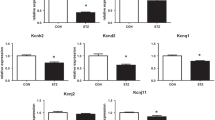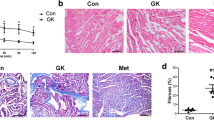Abstract
Intracellular Na+ ([Na+] i ) is an important modulator of excitation–contraction coupling via regulating Ca2+ efflux/influx, and no investigation has been so far performed in diabetic rat heart. Here, we examined whether any change of [Na+] i in paced cardiomyocytes could contribute to functional alterations during diabetes. Slowing down in depolarization phase of the action potential, small but significant decrease in its amplitude with a slight depolarized resting membrane potential was traced in live cardiomyocytes from diabetic rat, being parallel with a decreased TTX-sensitive Na+ channel current (I Na) density. We recorded either [Na+] i or [Ca2+] i by using a fluorescent Na+ indicator (SBFI-AM or Na-Green) or a Ca2+ indicator (Fura 2-AM) in freshly isolated cardiomyocytes. We examined both [Na+] i and [Ca2+] i at rest, and also [Na+] i during pacing with electrical field stimulation in a range of 0.2–2.0 Hz stimulation frequency. In order to test the possible contribution of Na+/H+ exchanger (NHE) to [Na+] i , we examined the free cytoplasmic [H+] i changes from time course of [H+] i recovery in cardiomyocytes loaded with SNARF1-AM by using ammonium prepulse method. Our data showed that [Na+] i in resting cells from either diabetic or control group was not significantly different, whereas the increase in [Na+] i was significantly smaller in paced diabetic cardiomyocytes compared to that of the controls. However, resting [Ca2+] i in diabetic cardiomyocytes was significantly higher than that of the controls. Here, a lower basal pH i in diabetics compared with the controls correlates also with a slightly higher but not significantly different NHE activity and consequently a similar Na+ loading rate at resting state with a leftward shift in pH sensitivity of NHE-dependent H+-flux. NHE protein level remained unchanged, while protein levels of Na+/K+ ATPase and Na+/Ca2+ exchanger were decreased in the diabetic cardiomyocytes. Taken together, the present data indicate that depressed I Na plays an important role in altered electrical activity with less Na+ influx during contraction, and an increased [Ca2+] i load in these cells seems to be independent of [Na+] i . The data with insulin treatment suggest further a recent balance between Na+ influx and efflux proteins associated with the [Na+] i , particularly during diabetes.





Similar content being viewed by others
References
Fein, F., Kornstein, L., Strobeck, J., & Sonnenblick, E. (1980). Altered myocardial mechanics in diabetic rats. Circulation Research, 47, 922–933.
Shimoni, Y., Firek, L., Severson, D., & Giles, W. (1994). Shortterm diabetes alters K+ currents in rat ventricular myocytes. Circulation Research, 74, 620–628.
Magyar, J., Rusznak, Z., Szentesi, P., Szucs, G., & Kovacs, L. (1992). Action potentials and potassium currents in rat ventricular muscle during experimental diabetes. Journal of Molecular Cell Cardiology, 24, 841–853.
Choi, K. M., Zhong, Y., Hoit, B. D., Grupp, I. L., Hahn, H., Dilly, K. W., et al. (2002). Defective intracellular Ca2+ signaling contributes to cardiomyopathy in Type 1 diabetic rats. American Journal of Physiology. Heart and Circulatory Physiology, 283, H1398–H1408.
Rubler, S., Dlugash, J., Yuceoglu, Y. Z., Kumral, T., Branwood, A. W., & Grishman, A. (1972). New type of cardiomyopathy associated with diabetic glomerulosclerosis. American Journal of Cardiology, 30, 595–602.
Bers, D. M., Eisner, D. A., & Valdivia, H. H. (2003). Sarcoplasmic reticulum Ca2+ and heart failure: Roles of diastolic leak and Ca2+ transport. Circulation Research, 93, 487–490.
Satoh, H., Hayashi, H., Katoh, H., Terada, H., & Kobayashi, A. (1995). Na+/H+ and Na+/Ca2+ exchange in regulation of [Na+] i and [Ca2+] i during metabolic inhibition. American Journal of Physiology, 268, H1239–H1248.
Seki, S., Taniguchi, M., Takeda, H., Nagai, M., Taniguchi, I., & Mochizuki, S. (2002). Inhibition by KB-r7943 of the reverse mode of the Na+/Ca2+ exchanger reduces Ca2+ overload in ischemic-reperfused rat hearts. Circulation Journal, 66, 390–396.
Pierce, G. N., & Dhalla, N. S. (1983). Sarcolemmal Na+-K+-ATPase activity in diabetic rat heart. American Journal of Physiology, 245, C241–C247.
Lagadic-Gossmann, D., Chesnais, J. M., & Feuvray, D. (1988). Intracellular pH regulation in papillary muscle cells from streptozotocin diabetic rats: An ion-sensitive microelectrode study. Pflügers Archiv, 412, 613–617.
Lopaschuk, G. D., Tahiliani, A. G., Vadlamudi, R. V., Katz, S., & McNeill, J. H. (1983). Cardiac sarcoplasmic reticulum function in insulin or carnitine created diabetic rats. American Journal of Physiology, 245, H969–H976.
Ayaz, M., Ozdemir, S., Ugur, M., Vassort, G., & Turan, B. (2004). Effects of selenium on altered mechanical and electrical cardiac activities of diabetic rat. Archives of Biochemistry and Biophysics, 426, 83–90.
Yaras, N., Ugur, M., Ozdemir, S., Gurdal, H., Purali, N., Lacampagne, A., et al. (2005). Effects of diabetes on ryanodine receptor Ca release channel (RyR2) and Ca2+ homeostasis in rat heart. Diabetes, 54, 3082–3088.
Anzawa, R., Ishikawa, S., Tanaka, Y., Okazaki, F., & Mochizuki, S. (2006). Increased AAI mode pacing threshold after termination of atrial fibrillation by acute administration of disopyramide phosphate. Europace, 8, 345–348.
Anzawa, R., Seki, S., Nagoshi, T., Taniguchi, I., Feuvray, D., & Yoshimura, M. (2012). The role of Na+/H+ exchanger in Ca2+ overload and ischemic myocardial damage in hearts from type 2 diabetic db/db mice. Cardiovascular Diabetology, 11, 33.
Williams, I. A., Xiao, X.-H., Ju, Y.-K., & Allen, D. G. (2007). The rise of [Na+] i during ischemia and reperfusion in the rat heart-underlying mechanisms. Pflügers ArchIV, 454, 903–912.
Yao, A., Su, Z., Nonaka, A., Zubair, I., Spitzer, K. W., Bridge, J. H., et al. (1998). Abnormal myocyte Ca2+ homeostasis in rabbits with pacing-induced heart failure. The American Journal of Physiology. Heart and Circulatory Physiology, 275, H1441–H1448.
Scamps, F., & Vassort, G. (1994). Effect of extracellular ATP on the Na+ current in rat ventricular myocytes. Circulation Research, 74, 710–717.
Birkedal, R., & Shiels, H. A. (2007). High [Na] i in cardiomyocytes from rainbow trout. American Journal of Physiology: Regulatory, Integrative and Comparative Physiology, 293, R861–R866.
Sugishita, K., Su, Z., Li, F., Philipson, K. D., & Barry, W. H. (2001). Gender influences [Ca2+] i during metabolic inhibition in myocytes overexpressing the Na+-Ca2+ exchanger. Circulation, 104, 2101–2106.
Buckler, K. J., & Vaughan Jones, R. D. (1990). Application of a new pH-sensitive fluoroprobe (carboxy-SNARF-1) for intracellular pH measurement in small, isolated cells. Pflugers Archiv. European Journal of Physiology, 417, 234–239.
Leem, C. H., Lagadic-Gossmann, D., & Vaughan-Jones, R. D. (1999). Characterization of intracellular pH regulation in the guinea-pig ventricular myocyte. Journal of Physiology, 517, 159–180.
Kushnir, A., Shan, J., Betzenhauser, M. J., Reiken, S., & Marks, A. R. (2010). Role of CaMKIIdelta phosphorylation of the cardiac ryanodine receptor in the force frequency relationship and heart failure. Proceedings of the National Academy of Sciences of the United States of America, 22, 10274–10279. (Epub 2010 May 17).
Vaughan-Jones, R. D., Villafuerte, F. C., Swietach, P., Yamamoto, T., Rossini, A., & Spitzer, K. W. (2006). pH-Regulated Na(+) influx into the mammalian ventricular myocyte: the relative role of Na(+)-H(+) exchange and Na(+)-HCO Co-transport. Journal of Cardiovascular Electrophysiology, 17(suppl. 1), S134–S140.
Lagadic-Gossmann, D., & Feuvray, D. (1991). Intracellular sodium activity in papillary muscle from diabetic rat hearts. Experimental Physiology, 76, 147–149.
Imahashi, K., Hashimoto, K., Yamaguchi, H., Nishimura, T., & Kusuoka, H. (1998). Alteration of intracellular Na+ during ischemia in diabetic rat hearts: The role of reduced activity in Na+/H+ exchange against stunning. Journal of Molecular and Cellular Cardiology, 30, 509–517.
Warley, A. (1991). Changes in sodium concentration in cardiac myocytes from diabetic rats. Scanning Microscopy, 5, 239–244.
Katoh, H., Noda, N., Hayashi, H., Satoh, H., Terada, H., Ohno, R., et al. (1995). Intracellular sodium concentration in diabetic rat ventricular myocytes. Japanese Heart Journal, 5, 647–656.
Gray, R. P., McIntyre, H., Sheridan, D. S., & Fry, C. H. (2001). Intracellular sodium and contractile function in hypertrophied human and guinea-pig myocardium. Pflugers Archiv. European Journal of Physiology, 442, 117–123.
Tani, M., & Neely, J. R. (1990). Na+ accumulation increases Ca2+ overload and impairs function in anoxic rat heart. Journal of Molecular and Cellular Cardiology, 22, 57–72.
Smogorzewski, M., Galfayan, V., & Massry, S. G. (1998). High glucose concentration causes a rise in [Ca2+] i of cardiac myocytes. Kidney International, 53, 1237–1243.
Acknowledgments
This work has been supported by grants from Ankara University Scientific Research Projects (project no. 12B3330005). Authors thank to A. A. Seymen for his technical assistance for patch-clamp experiments.
Author information
Authors and Affiliations
Corresponding author
Rights and permissions
About this article
Cite this article
Bilginoglu, A., Kandilci, H.B. & Turan, B. Intracellular Levels of Na+ and TTX-sensitive Na+ Channel Current in Diabetic Rat Ventricular Cardiomyocytes. Cardiovasc Toxicol 13, 138–147 (2013). https://doi.org/10.1007/s12012-012-9192-9
Published:
Issue Date:
DOI: https://doi.org/10.1007/s12012-012-9192-9




